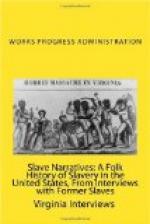A SLAVE REMEMBERS
The front door of a little vine-clad cottage on Billups Street, in Athens, Georgia quaked open and John Cole, ex-slave confronted a “gov’mint man.”
[Illustration]
Yes, he was the son of Lucius Cole and Betsy Cole, was in his 86th year, and remembered the time “way back” when other gov’mint men with their strange ways had descended on Athens.
And far beyond that, back to the time when they had tried him out as a scullion boy in the big town house where his mother was the cook, but it seemed that the trays always escaped his clumsy young hands.
So “Marse Henry” had put him on the 200 acre Oglethorpe plantation as apprentice to training of the farm horses whose large unmanageableness he found more manageable than the dainty china of the banker’s house. He simply had followed more after his father, the carriage driver than his mother, the cook.
Of course, all fifteen of the hands worked from sun-up to sun-down, but his aunt was the plantation cook, and it was not so bad there.
The night brought no counsel, but it brought better. Stretch cow-hides over cheese-boxes and you had tambourines. Saw bones from off a cow, knock them together, and call it [HW: a drum]. Or use broom-straws, on fiddle-strings, and you had your entire orchestra.
Grow older, and get by the gates with a pass (you had to have a pass or the paddle-rollers would get you,) and you had you a woman. If the woman wasn’t willing, a good, hard-working hand could always get the master to make the girl marry him—whether or no, willy-nilly.
If a hand were noted for raising up strong black bucks, bucks that would never “let the monkey get them” while in the high-noon hoeing, he would be sent out as a species of circuit-rider to the other plantations—to plantations where there was over-plus of “worthless young nigger gals”. There he would be “married off” again—time and again. This was thrifty and saved any actual purchase of new stock.
Always on Saturday afternoon you would have till “first dark” for base-ball, and from first dark till Sunday-go-to meeting for drinking and dancing. Sunday you could go to the colored church (with benefit of white clergy) or you could go to the white church just like real class except you sat in the rear.
No, it was not a bad life.
You usually weren’t sick, but if you were sick, it afforded you the luxury of tea. Turpentine and caster oil composed the entire materia medica. Turpentine was used for sore throats, cuts and bruises. Castor oil was used for everything else except a major fracture which called for the master sending in a doctor to the quarters.




